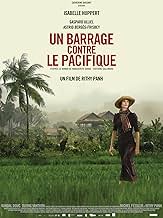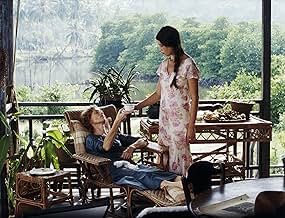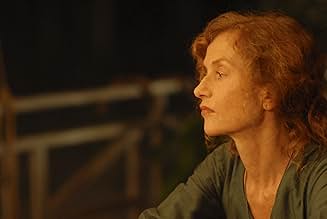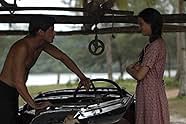A troubled mother's spirit crumbles when her adult children strike out for independence. Feeling abandoned she contemplates taking drastic action.A troubled mother's spirit crumbles when her adult children strike out for independence. Feeling abandoned she contemplates taking drastic action.A troubled mother's spirit crumbles when her adult children strike out for independence. Feeling abandoned she contemplates taking drastic action.
- Awards
- 1 nomination
Vanthon Duong
- Le caporal
- (as Duong Vanthon)
Chorn Solyda
- Le père Sok
- (as Solida Chorn)
- Director
- Writers
- All cast & crew
- Production, box office & more at IMDbPro
Storyline
Did you know
- TriviaJuliette Binoche was considered for the role of the mother.
- ConnectionsRemake of This Angry Age (1958)
Featured review
'The Sea Wall' directed in 2008 by Cambodian director Rithy Panh is the second screen adaptation of Marguerite Duras's novel 'Un barrage contre le Pacifique' after the one made in 1957 by René Clément, a few years after the novel was published. The French writer was also a prolific screenwriter and collaborated with some of the best-known contemporary directors of her time with original scripts and adaptations of her books. I believe that she would have liked this film, which was made a decade after the writer's death. The screenplay follows the story with a strong autobiographical touch in the book, inspired by the childhood and adolescence spent by the writer in Indochina in the interwar period. The adaptation is faithful to the book, with an extra authenticity derived from on-site filming in Cambodia and the contribution of Rithy Panh who is also an excellent documentary filmmaker. It is one of those cases where the remake is justified and the result, although far in time, is I think closer to the characters and messages of the book than the first film.
'The Sea Wall' is the story of a woman, a widow who raises her two children, a 19-year-old boy and a 16-year-old daughter, in the difficult conditions of French colonial Indochina. Her rice plantation is located near the ocean and colonial officials tricked her by lending her money for land subject to meteorological whims. The construction of a dam goes beyond the simple necessity, it becomes a symbol of the struggle with nature but also of the confrontations with a bureaucracy that cruelly exploits not only the locals but also the French colonists who do not have enough money or relations to fit in the upper echelons of the social and economic hierarchy. The mother's war of survival overlaps with the maturing crises of the children, the difficult relations between the three family members being complicated by the need to survive economically even at the cost of moral compromises.
Marguerite Duras's Indochina in Rithy Panh's vision is a country of social and racial inequalities, and of political and economic conflicts presented unabashedly, in a realistic, almost naturalistic style. Between René Clément's 1957 film and this film version, the Cambodian tragedy of the 1970s took place and the Cambodian director did not hesitate to suggest that there, in the country's colonial past, lies much of the roots of the Khmer Rouge's cruelty. Isabelle Huppert creates here another of her great roles as a woman beyond her prime, who tries to navigate between the blows of fate and family conflicts, torn between the desire to raise her children decently and the compromises she cannot avoid. The two young actors who play the roles of young people, Gaspard Ulliel and Astrid Bergès-Frisbey are both excellently cast and act strongly, with a combination of innocence and sensuality, two characters who shape themselves as the story progresses. The cinematography plays an important role in creating the atmosphere, because the weather conditions decide the fate of the heroes. One can blame the film for a certain lack of rhythm. It could be an intentional decision of the director to involve the viewer in the sensations of the heavy flow of time that the heroes feel. The cinematic narrative omits or passes very quickly over some of the important aspects of the story, especially in the second part of the film, which may make the accumulation of events at the end less clear to those who have not read the book or seen the older version of the movie. Even so, I believe that 'The Sea Wall' is a film worth watching or watching again, which fits with honor in the series of films through which French cinema critically and without nostalgia revisits the country's colonial past.
'The Sea Wall' is the story of a woman, a widow who raises her two children, a 19-year-old boy and a 16-year-old daughter, in the difficult conditions of French colonial Indochina. Her rice plantation is located near the ocean and colonial officials tricked her by lending her money for land subject to meteorological whims. The construction of a dam goes beyond the simple necessity, it becomes a symbol of the struggle with nature but also of the confrontations with a bureaucracy that cruelly exploits not only the locals but also the French colonists who do not have enough money or relations to fit in the upper echelons of the social and economic hierarchy. The mother's war of survival overlaps with the maturing crises of the children, the difficult relations between the three family members being complicated by the need to survive economically even at the cost of moral compromises.
Marguerite Duras's Indochina in Rithy Panh's vision is a country of social and racial inequalities, and of political and economic conflicts presented unabashedly, in a realistic, almost naturalistic style. Between René Clément's 1957 film and this film version, the Cambodian tragedy of the 1970s took place and the Cambodian director did not hesitate to suggest that there, in the country's colonial past, lies much of the roots of the Khmer Rouge's cruelty. Isabelle Huppert creates here another of her great roles as a woman beyond her prime, who tries to navigate between the blows of fate and family conflicts, torn between the desire to raise her children decently and the compromises she cannot avoid. The two young actors who play the roles of young people, Gaspard Ulliel and Astrid Bergès-Frisbey are both excellently cast and act strongly, with a combination of innocence and sensuality, two characters who shape themselves as the story progresses. The cinematography plays an important role in creating the atmosphere, because the weather conditions decide the fate of the heroes. One can blame the film for a certain lack of rhythm. It could be an intentional decision of the director to involve the viewer in the sensations of the heavy flow of time that the heroes feel. The cinematic narrative omits or passes very quickly over some of the important aspects of the story, especially in the second part of the film, which may make the accumulation of events at the end less clear to those who have not read the book or seen the older version of the movie. Even so, I believe that 'The Sea Wall' is a film worth watching or watching again, which fits with honor in the series of films through which French cinema critically and without nostalgia revisits the country's colonial past.
- How long is The Sea Wall?Powered by Alexa
Details
- Release date
- Countries of origin
- Official site
- Language
- Also known as
- The Sea Wall
- Filming locations
- Ream National Park, Preah Sihanouk, Cambodia(1930's Cambodia)
- Production companies
- See more company credits at IMDbPro
Box office
- Budget
- €6,245,716 (estimated)
- Gross worldwide
- $1,550,661
- Runtime1 hour 56 minutes
- Color
Contribute to this page
Suggest an edit or add missing content

Top Gap
By what name was Un barrage contre le Pacifique (2008) officially released in Canada in English?
Answer























